Deficit Drip Irrigation in Processing Tomato Production in the Mediterranean Basin. A Data Analysis for Italy
Abstract
1. Introduction
2. Materials and Methods
2.1. Data Collection and Case Studies
2.1.1. Apulia
2.1.2. Basilicata
2.1.3. Latium
2.1.4. Sicily
2.2. Data Evaluation
3. Results
3.1. Marketable Yield and Water Restoration
3.2. Irrigation Water Use Efficiency and Water Restoration
4. Discussion
5. Conclusions and Recommendations
Supplementary Materials
Author Contributions
Funding
Conflicts of Interest
References
- FAO (Food and Agriculture Organization of the United Nations). FAO Statistical Yearbook 2012. Available online: http://www.fao.org/docrep/015/i2490e/i2490e00.htm (accessed on 7 April 2019).
- Du, Y.D.; Niu, W.Q.; Gu, X.B.; Zhang, Q.; Cui, B.J. Water- and nitrogen-saving potentials in tomato production: A meta-analysis. Agr. Water Manag. 2018, 210, 296–303. [Google Scholar] [CrossRef]
- Molden, D. Water for Food, Water for Life: A Comprehensive Assessment of Water Management in Agriculture; Earthscan and Colombo, International Water Management Institute: London, UK, 2007; 688p. [Google Scholar]
- FAO (Food and Agriculture Organization of the United Nations). AQUASTAT Main Database 2016. Available online: http://www.fao.org/nr/water/aquastat/data/query/index.html (accessed on 7 April 2019).
- Yahyaoui, I.; Tadeo, F.; Vieira, M. Energy and water management for drip-irrigation of tomatoes in a semi-arid district. Agr. Water Manag. 2017, 183, 4–15. [Google Scholar] [CrossRef]
- Costa, J.M.; Ortuno, M.F.; Chaves, M.M. Deficit irrigation as a strategy to save water: Physiology and potential application to horticulture. J. Integr. Plant Biol. 2007, 49, 1421–1434. [Google Scholar] [CrossRef]
- Mushtaq, S.; Moghaddasi, M. Evaluating the potentials of deficit irrigation as an adaptive response to climate change and environmental demand. Environ. Sci. Policy 2011, 14, 1139–1150. [Google Scholar] [CrossRef]
- Ali, M.H.; Hoque, M.R.; Hassan, A.A.; Khair, A. Effects of deficit irrigation on yield, water productivity, and economic returns of wheat. Agr. Water Manag. 2007, 92, 151–161. [Google Scholar] [CrossRef]
- Vazifedoust, M.; Van Dam, J.C.; Feddes, R.A.; Feizi, M. Increasing water productivity of irrigated crops under limited water supply at field scale. Agr. Water Manag. 2008, 95, 89–102. [Google Scholar] [CrossRef]
- Rodriguez-Ortega, W.; Martinez, V.; Rivero, R.; Camara-Zapata, J.; Mestre, T.; Garcia-Sanchez, F. Use of a smart irrigation system to study the effects of irrigation management on the agronomic and physiological responses of tomato plants grown under different temperatures regimes. Agr. Water Manag. 2017, 183, 158–168. [Google Scholar] [CrossRef]
- Zegbe-Domínguez, J.A.; Behboudian, M.H.; Lang, A.; Clothier, B.E. Deficit irrigation and partial rootzone drying maintain fruit dry mass and enhance fruit quality in ‘Petopride’ processing tomato (Lycopersicon esculentum, Mill.). Sci. Hortic. 2003, 98, 505–510. [Google Scholar] [CrossRef]
- Patanè, C.; Tringali, S.; Sortino, O. Effects of deficit irrigation on biomass, yield, water productivity and fruit quality of processing tomato under semi-arid Mediterranean climate conditions. Sci. Hortic. 2011, 129, 590–596. [Google Scholar] [CrossRef]
- Zhang, H.M.; Xiong, Y.W.; Huang, G.H.; Xu, X.; Huang, Q.Z. Effects of water stress on processing tomatoes yield, quality and water use efficiency with plastic mulched drip irrigation in sandy soil of the Hetao Irrigation District. Agric. Water Manag. 2017, 179, 205–214. [Google Scholar] [CrossRef]
- Chen, J.L.; Kang, S.Z.; Du, T.S.; Guo, P.; Qiu, R.Q.; Chen, R.Q.; Gu, F. Modeling relations of tomato yield and fruit quality with water deficit at different growth stages under greenhouse condition. Agr. Water Manag. 2014, 146, 131–148. [Google Scholar] [CrossRef]
- WPTC (World Processing Tomato Council). Available online: http://www.wptc.to/ (accessed on 22 March 2019).
- ISTAT (Istituto Nazionale di Statistica). Available online: http://agri.istat.it/ (accessed on 22 March 2019).
- Battilani, A. Processing tomato water and nutrient integrated crop management: State of art and future horizons. Acta Hortic. 2003, 613, 63–73. [Google Scholar] [CrossRef]
- Rinaldi, M.M.; Thebaldi, M.S.; da Rocha, M.S.; Sandri, D.; Felisberto, A.B. Postharvest quality of the tomato irrigated by different irrigation systems and water qualities. IRRIGA 2013, 18, 59–72. [Google Scholar] [CrossRef]
- Benincasa, P.; Guiducci, M.; Tei, F. The nitrogen use efficiency: Meaning and sources of variation – case studies on three vegetable crops in Central Italy. Hort. Technol. 2011, 21, 266–273. [Google Scholar] [CrossRef]
- Fereres, E.; Soriano, M.A. Deficit irrigation for reducing agricultural water use. J. Exp. Bot. 2007, 58, 147–159. [Google Scholar] [CrossRef] [PubMed]
- Giuliani, M.; Nardella, E.; Gagliardi, A.; Gatta, G. Deficit irrigation and partial root-zone drying techniques in processing tomato cultivated under Mediterranean climate conditions. Sustainability 2017, 9, 2197. [Google Scholar] [CrossRef]
- Rinaldi, M.; Garofalo, P.; Vonella, A.V. Productivity and water use efficiency in processing tomato under deficit irrigation in Southern Italy. In XIII International Symposium on Processing Tomato, Sirmione, Italy. Acta Hort. 2015, 1081, 97–104. [Google Scholar] [CrossRef]
- Ventrella, D.; Giglio, L.; Charfeddine, M.; Lopez, R.; Castellini, M.; Sollitto, D.; Castrignanò, A.; Fornaro, F. Climate change impact on crop rotations of winter durum wheat and tomato in southern Italy: Yield analysis and soil fertility. Ital. J. Agron. 2012, 7, 15. [Google Scholar] [CrossRef]
- Ventrella, D.; Giglio, L.; Garofalo, P.; Dalla Marta, A. Regional assessment of green and blue water consumption for tomato cultivated in Southern Italy. J. Agr. Sci. 2018, 156, 689–701. [Google Scholar] [CrossRef]
- Marouelli, W.A.; Silva, W.L.C. Water tension thresholds for processing tomatoes under drip irrigation in Central Brazil. Irrig. Sci. 2007, 25, 411–418. [Google Scholar] [CrossRef]
- Patanè, C.; Cosentino, S.L. Effects of soil water deficit on yield and quality of processing tomato under a Mediterranean climate. Agr. Water Manag. 2010, 97, 131–138. [Google Scholar] [CrossRef]
- Allen, R.G.; Pereira, L.S.; Raes, D.; Smith, M. Crop evapotranspiration. In Guidelines for Computing Crop Water Requirements; FAO: Rome, Italy, 1998; Irrigation and Drainage Paper Volume 56, p. 300. [Google Scholar]
- Doorenbos, J.; Pruitt, W.O. Crop Water Requirements; FAO Irrigation and Drainage Paper 24; FAO: Rome, Italy, 1977; p. 144. [Google Scholar]
- Cantore, V.; Lechkar, O.; Karabulut, E.; Sellami, M.H.; Albrizio, R.; Boari, F.; Stellacci, A.M.; Todorovic, M. Combined effect of deficit irrigation and strobilurin application on yield, fruit quality and water use efficiency of “cherry” tomato (Solanum lycopersicum L.). Agr. Water Manag. 2016, 167, 53–61. [Google Scholar] [CrossRef]
- Giuliani, M.M.; Gatta, G.; Nardella, E.; Tarantino, E. Water saving strategies assessment on processing tomato cultivated in Mediterranean region. Ital. J. Agron. 2016, 11, 69–76. [Google Scholar] [CrossRef]
- Lovelli, S.; Potenza, G.; Castronuovo, D.; Perniola, M.; Candido, V. Yield, quality and water use efficiency of processing tomatoes produced under different irrigation regimes in Mediterranean environment. Ital. J. Agron. 2017, 12, 17–24. [Google Scholar] [CrossRef]
- Leogrande, R.; Lopedota, O.; Montemurro, F.; Vitti, C.; Ventrella, D. Effects of irrigation regime and salinity on soil characteristics and yield of tomato. Ital. J. Agron. 2012, 7, 50–57. [Google Scholar] [CrossRef]
- Candido, V.; Campanelli, G.; D’Addabbo, T.; Castronuovo, D.; Perniola, M.; Camele, I. Growth and yield promoting effect of artificial mycorrhization on field tomato at different irrigation regimes. Sci. Hortic. 2015, 187, 35–43. [Google Scholar] [CrossRef]
- Colla, G.; Casa, R.; Lo Cascio, B.; Saccardo, F.; Temperini, O.; Leoni, C. Responses of processing tomato to water regime and fertilization in Central Italy. In Proceedings of the VI International Symposium on Processing Tomato and Workshop on Irrigation and Fertigation of Processing Tomato, Pamplona, Spain. Acta Hort. 1999, 487, 531–536. [Google Scholar] [CrossRef]
- Casa, R.; Rouphael, Y. Effects of partial root-zone drying irrigation on yield, fruit quality, and water-use efficiency in processing tomato. J. Hortic. Sci. Biotech. 2014, 89, 389–396. [Google Scholar] [CrossRef]
- Howell, T.A.; Steiner, J.E.; Schneider, A.D.; Evertt, S.R.; Tolk, J.A. Seasonal and maximum daily evapotranspiration of irrigated winter wheat, sorghum and corn: Southern high plains. Trans. Asae 1997, 40, 623–634. [Google Scholar] [CrossRef]
- De Martonne, E. Une nouvelle fonction climatologique: l’indice d’aridite. Meteorologie 1926, 2, 449–458. [Google Scholar]
- Soil Survey Staff. Keys to Soil Taxonomy, 12th ed.; USDA-Natural Resources Conservation Service: Washington, DC, USA, 2014; p. 360.
- Zornoza, R.; Rosales, R.M.; Acosta, J.A.; de la Rosa, J.M.; Arcenegui, V.; Faz, Á.; Pérez-Pastor, A. Efficient irrigation management can contribute to reduce soil CO2 emissions in agriculture. Geoderma 2016, 263, 70–77. [Google Scholar] [CrossRef]
- Cayuela, M.L.; Aguilera, E.; Sanz-Cobena, A.; Adams, D.C.; Abalos, D.; Barton, L.; Ryals, R.; Silver, W.L.; Alfaro, M.A.; Pappa, V.A.; et al. Direct nitrous oxide emissions in Mediterranean climate cropping systems: Emission factors based on a meta-analysis of available measurement data. Agr. Ecosyst. Environ. 2017, 238, 25–35. [Google Scholar] [CrossRef]
- Zotarelli, L.; Dukes, M.D.; Scholberg, J.M.S.; Munoz-Carpena, R.; Icerman, J. Tomato nitrogen accumulation and fertilizer use efficiency on a sandy soil, as affected by nitrogen rate and irrigation scheduling. Agr. Water Manag. 2009, 96, 1247–1258. [Google Scholar] [CrossRef]
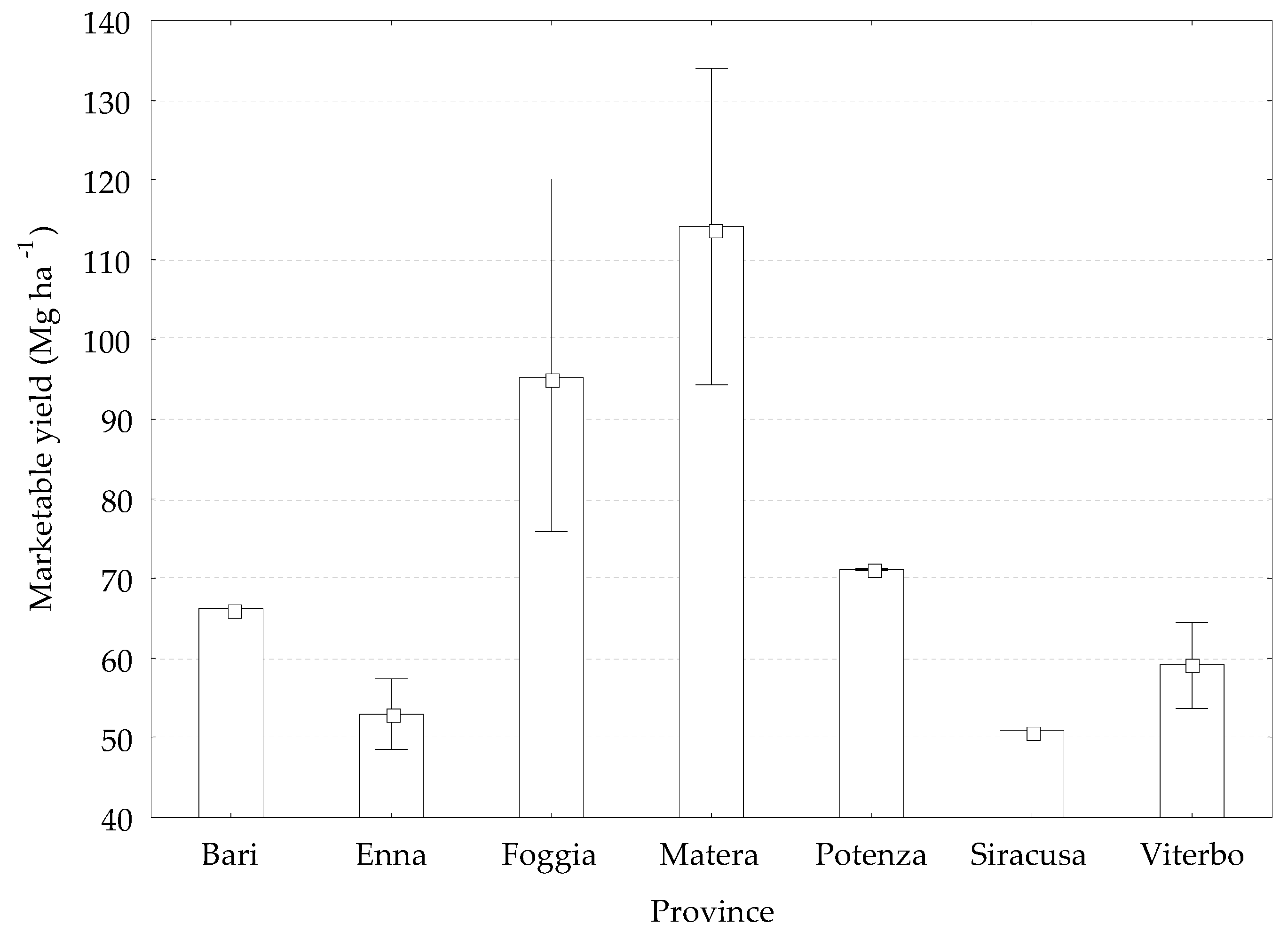
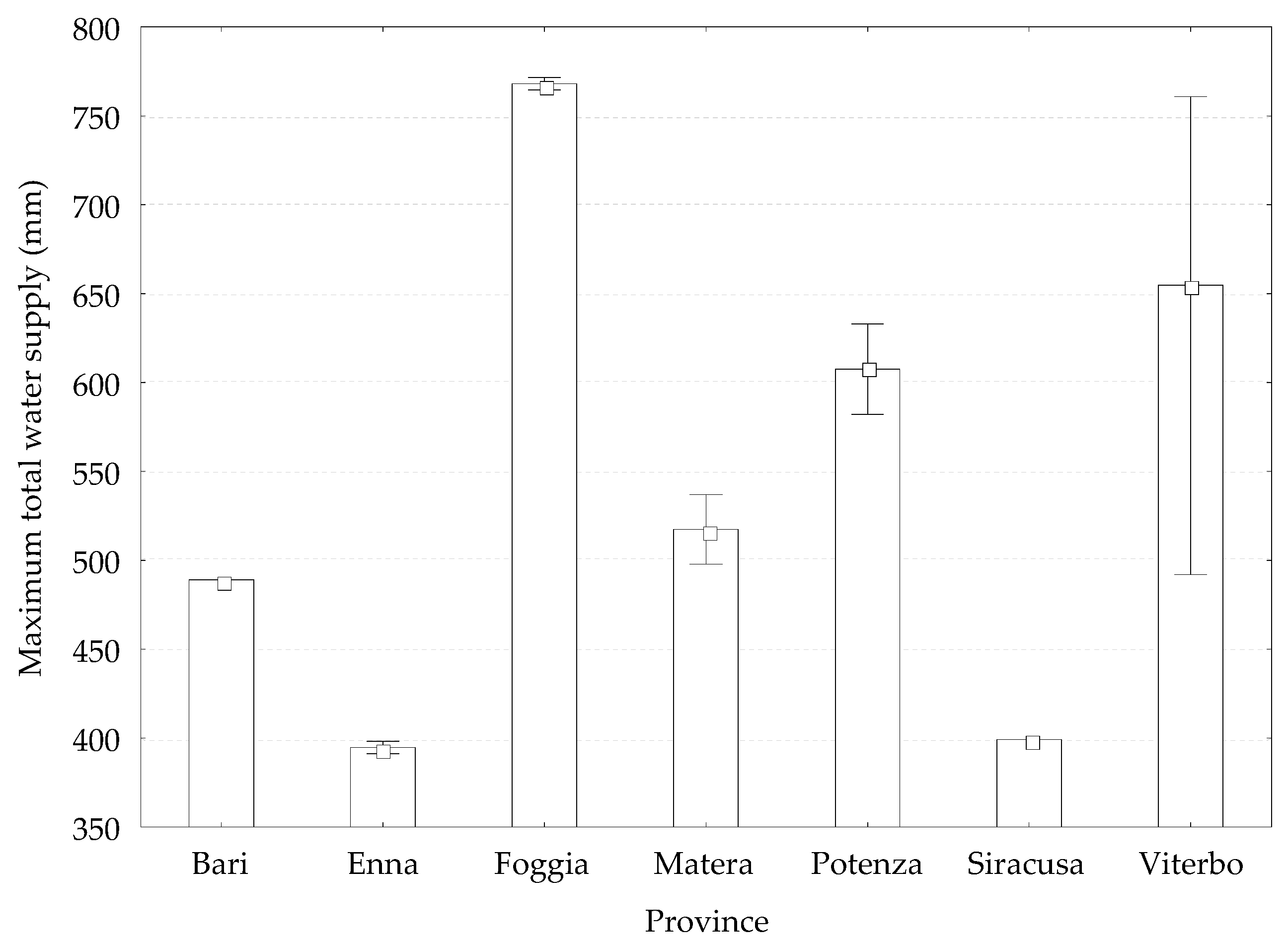
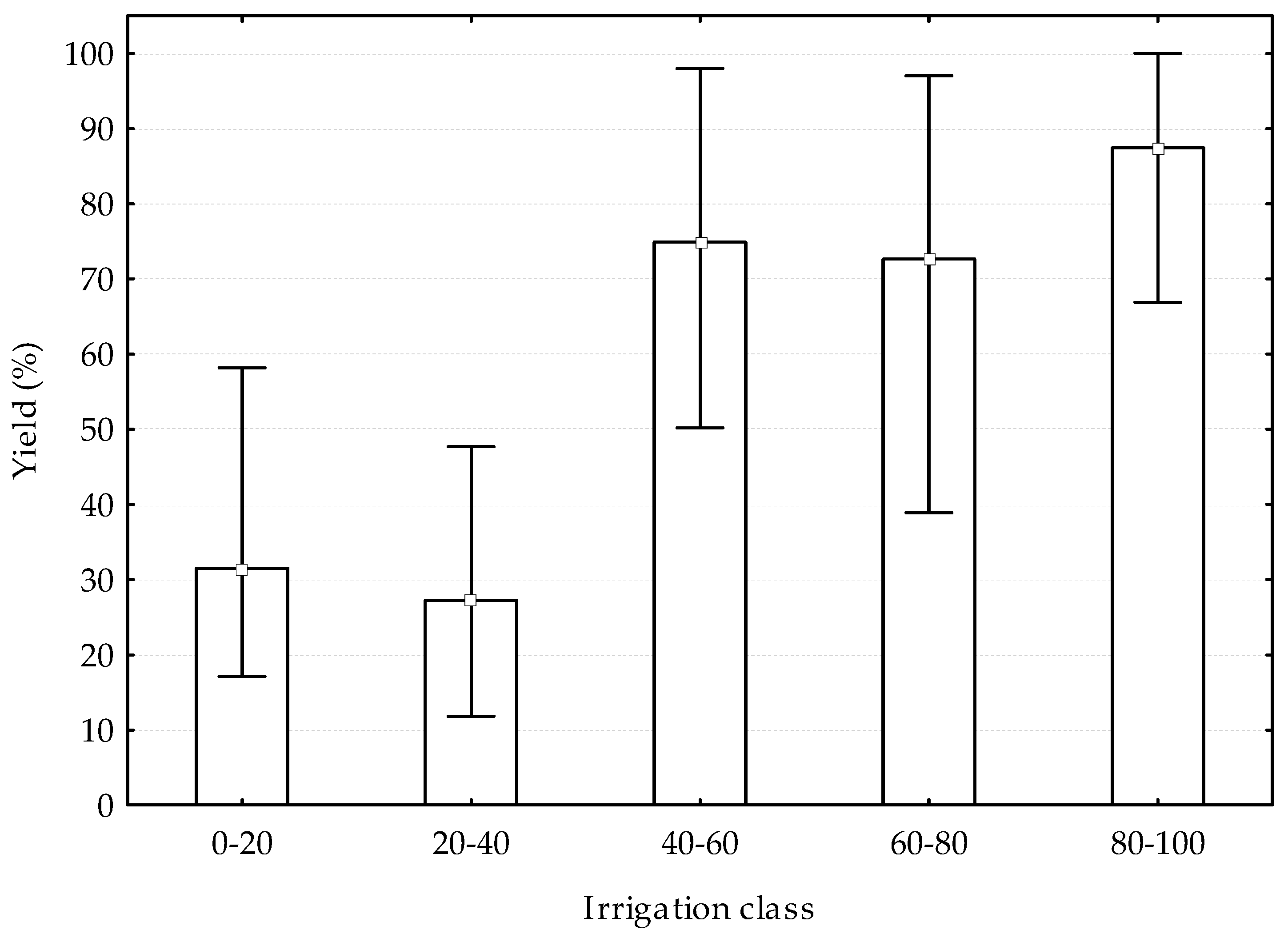
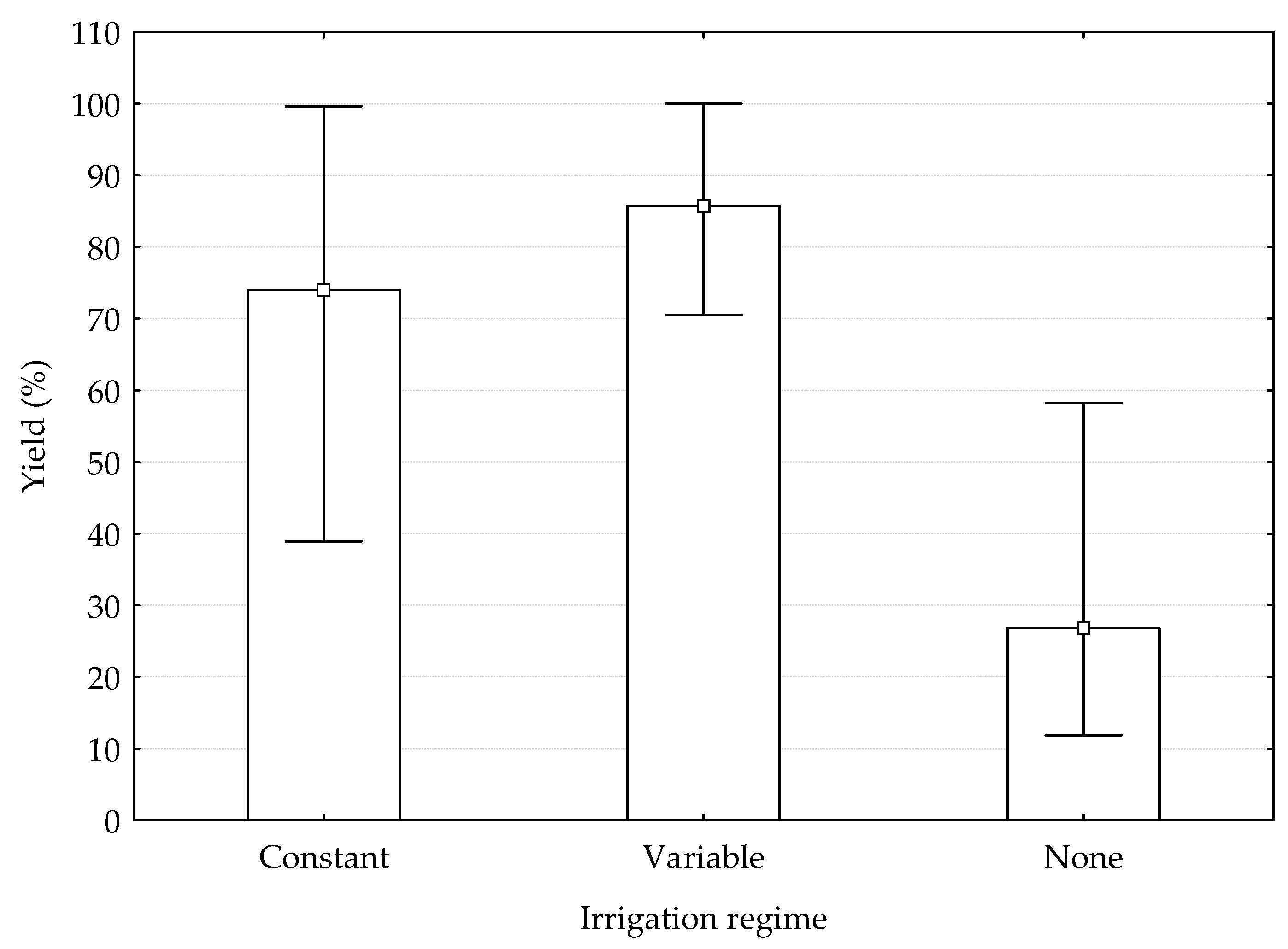
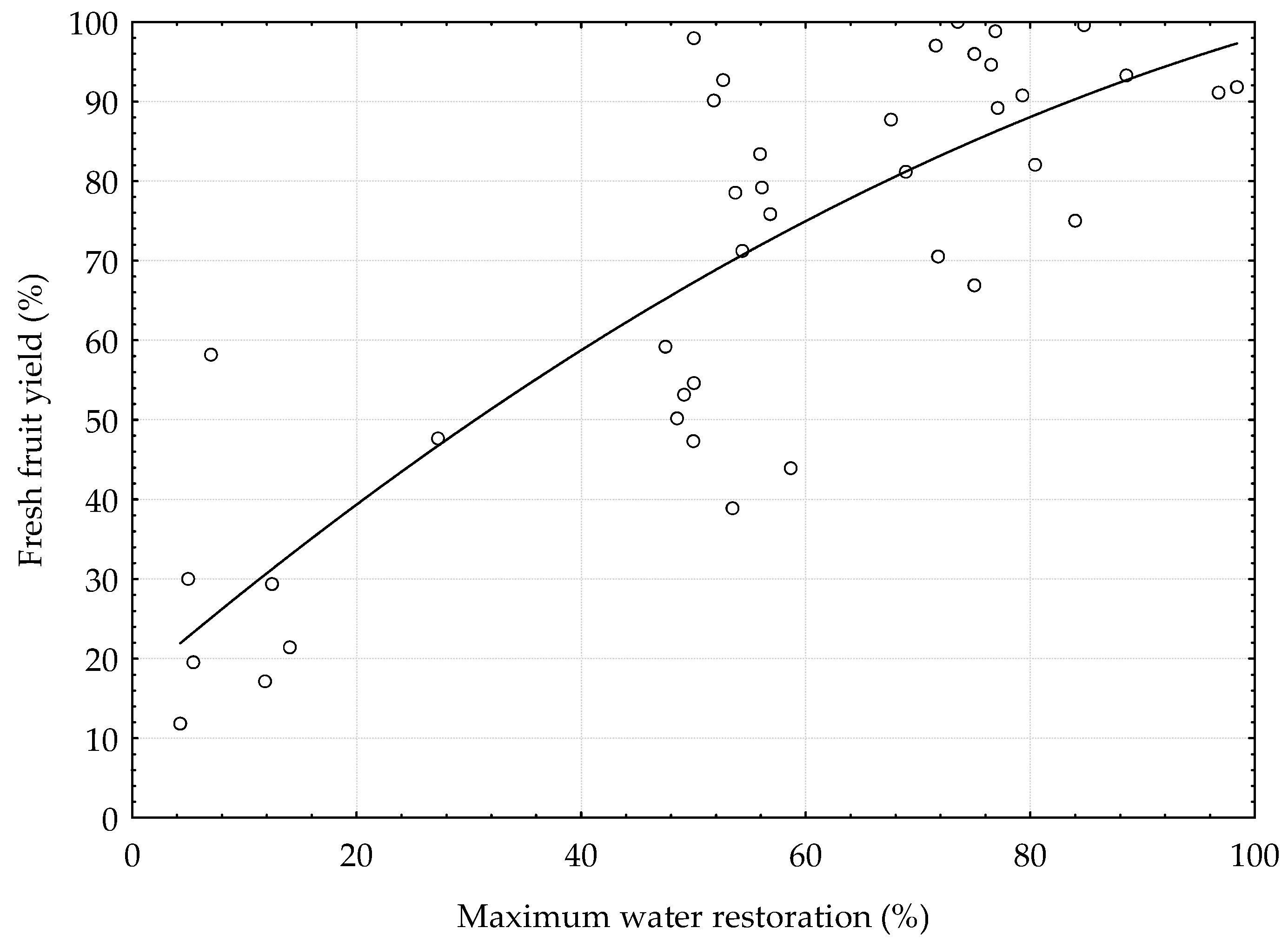
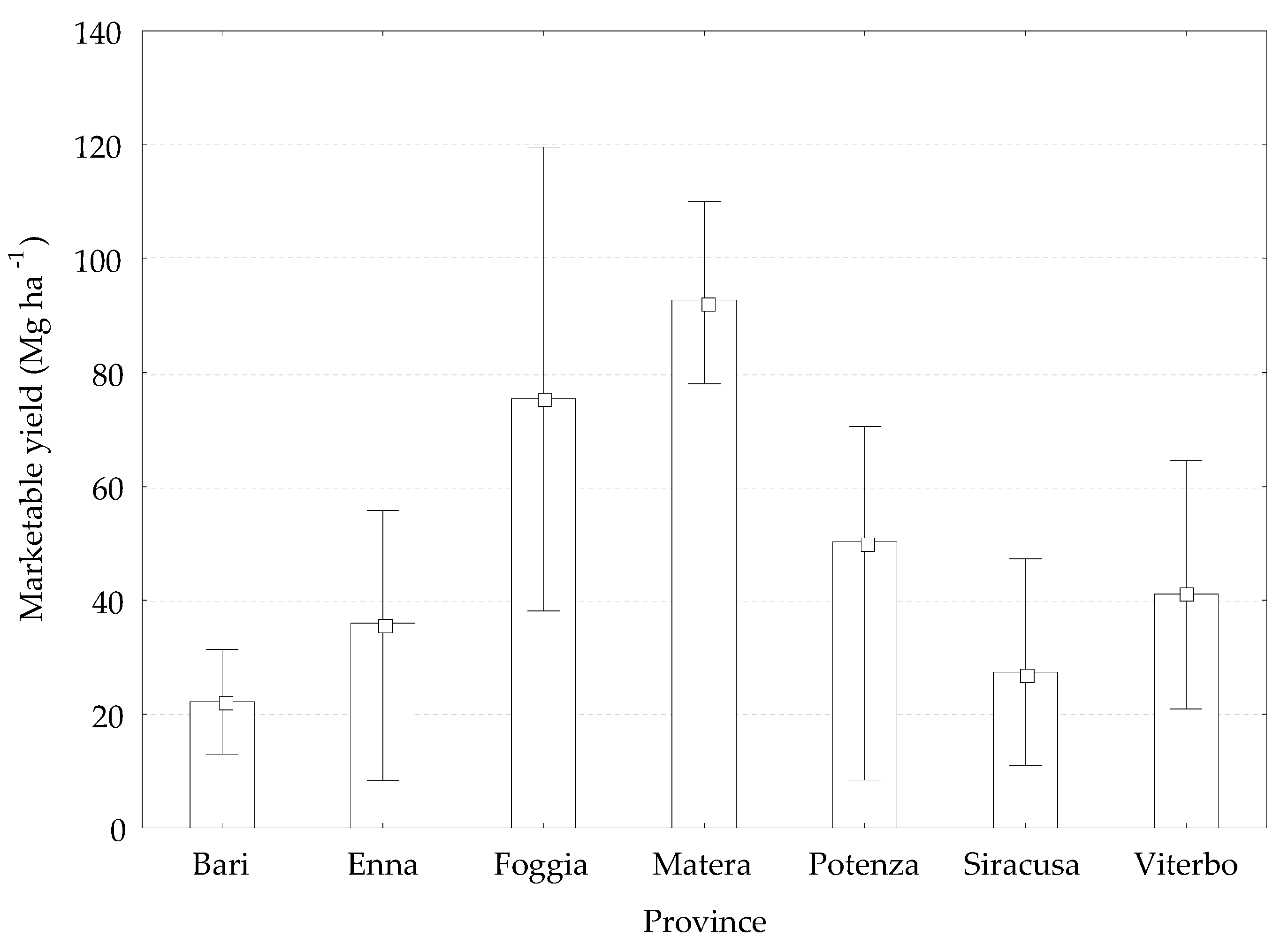
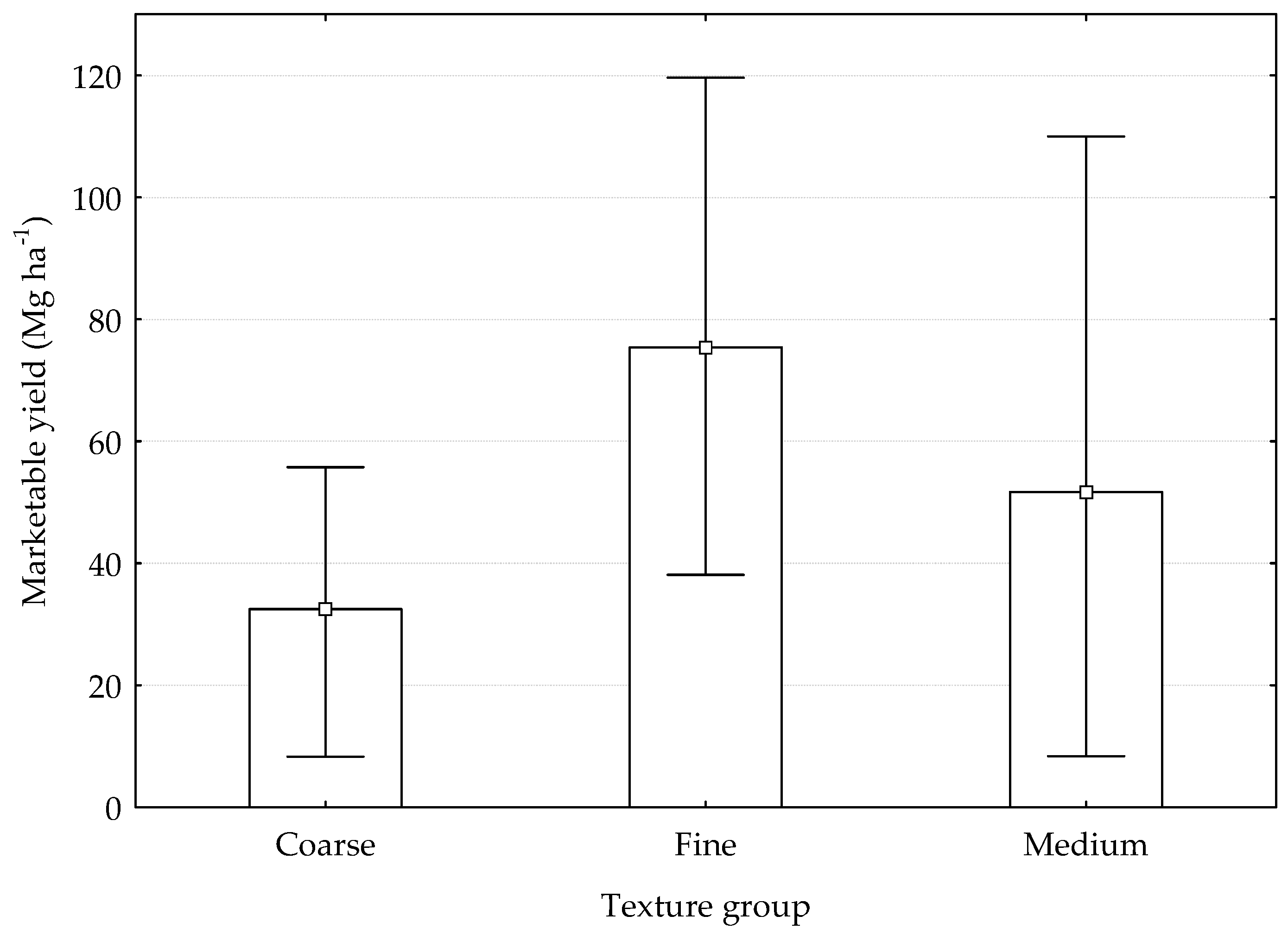
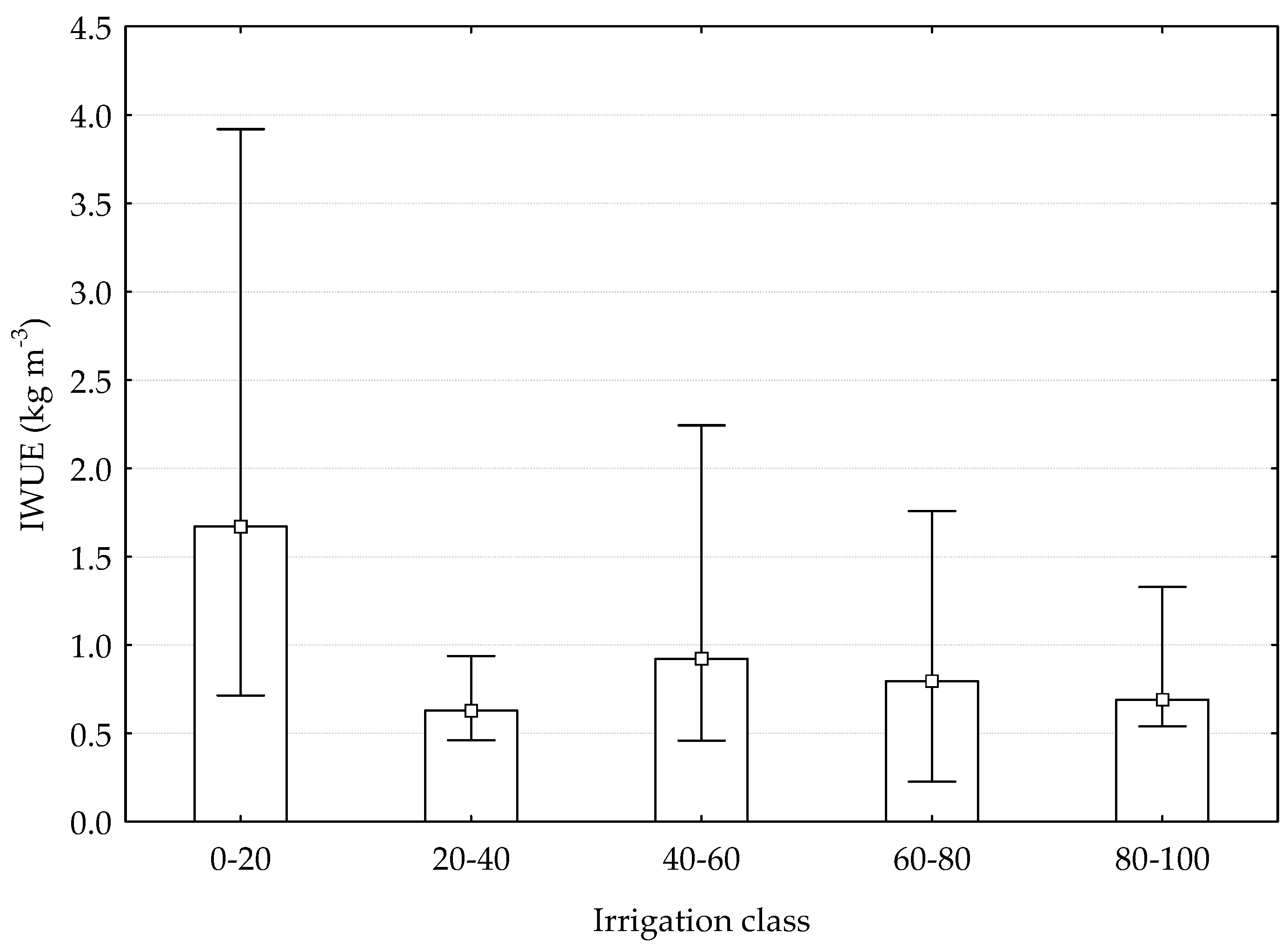
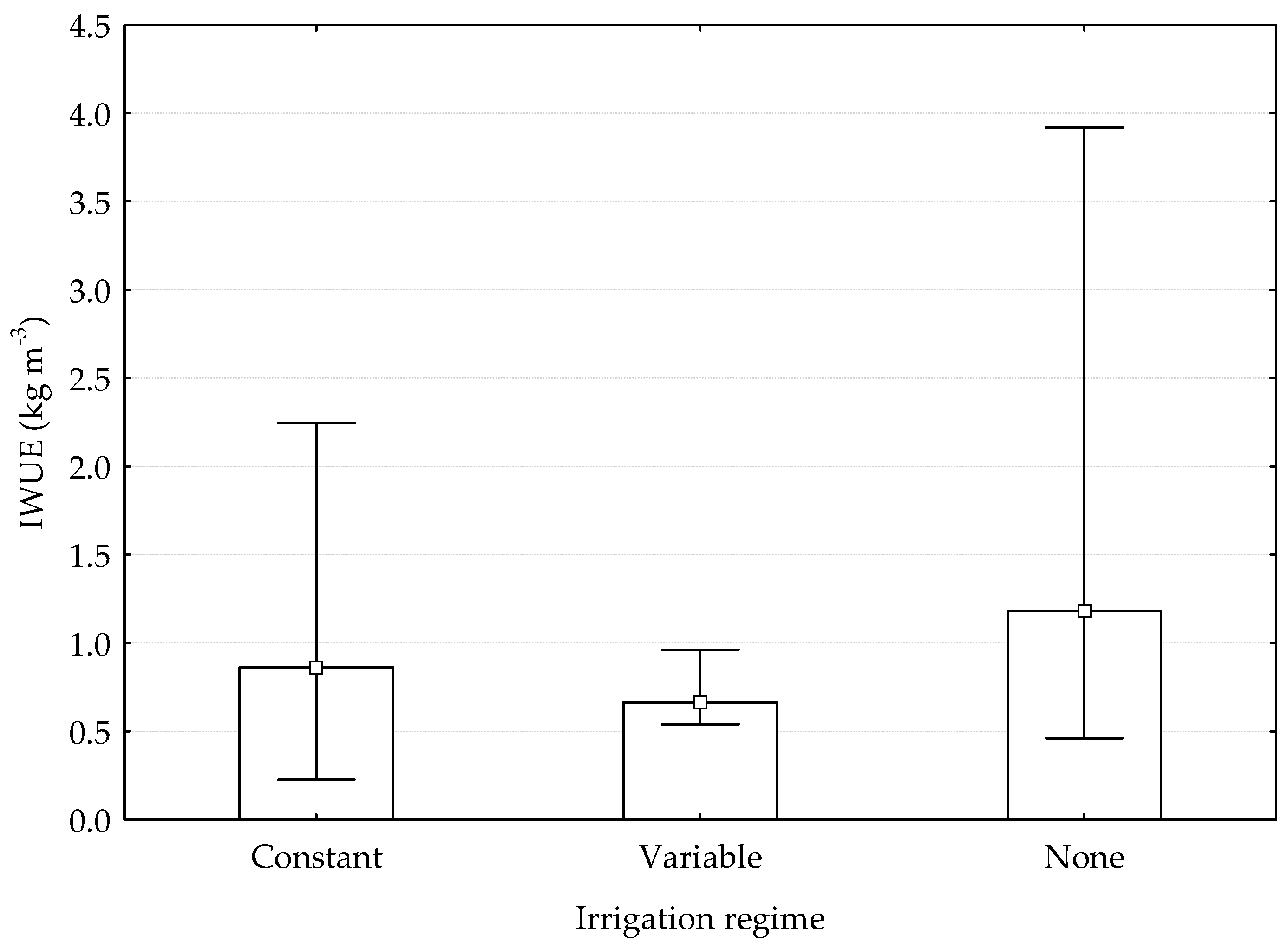
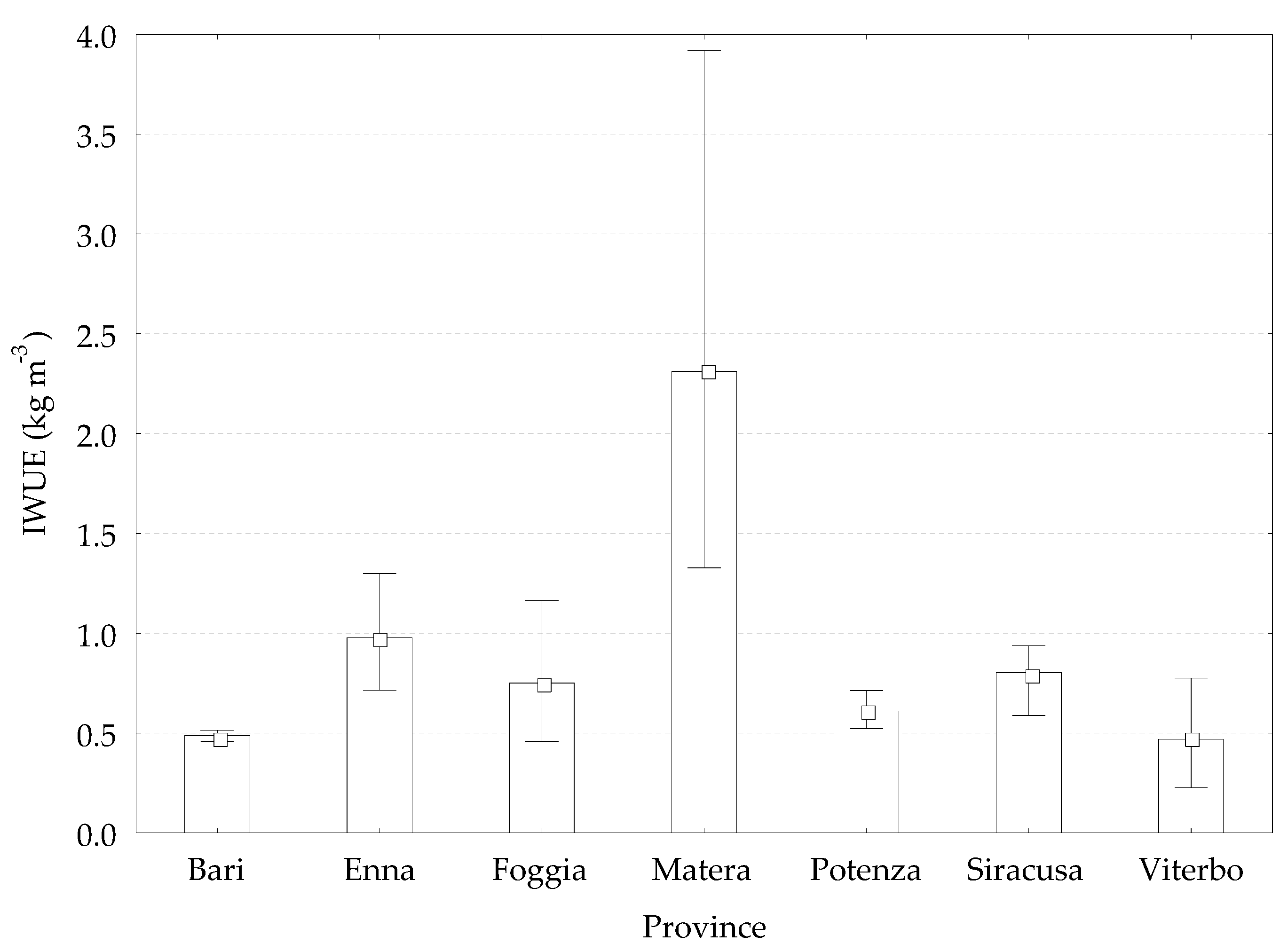
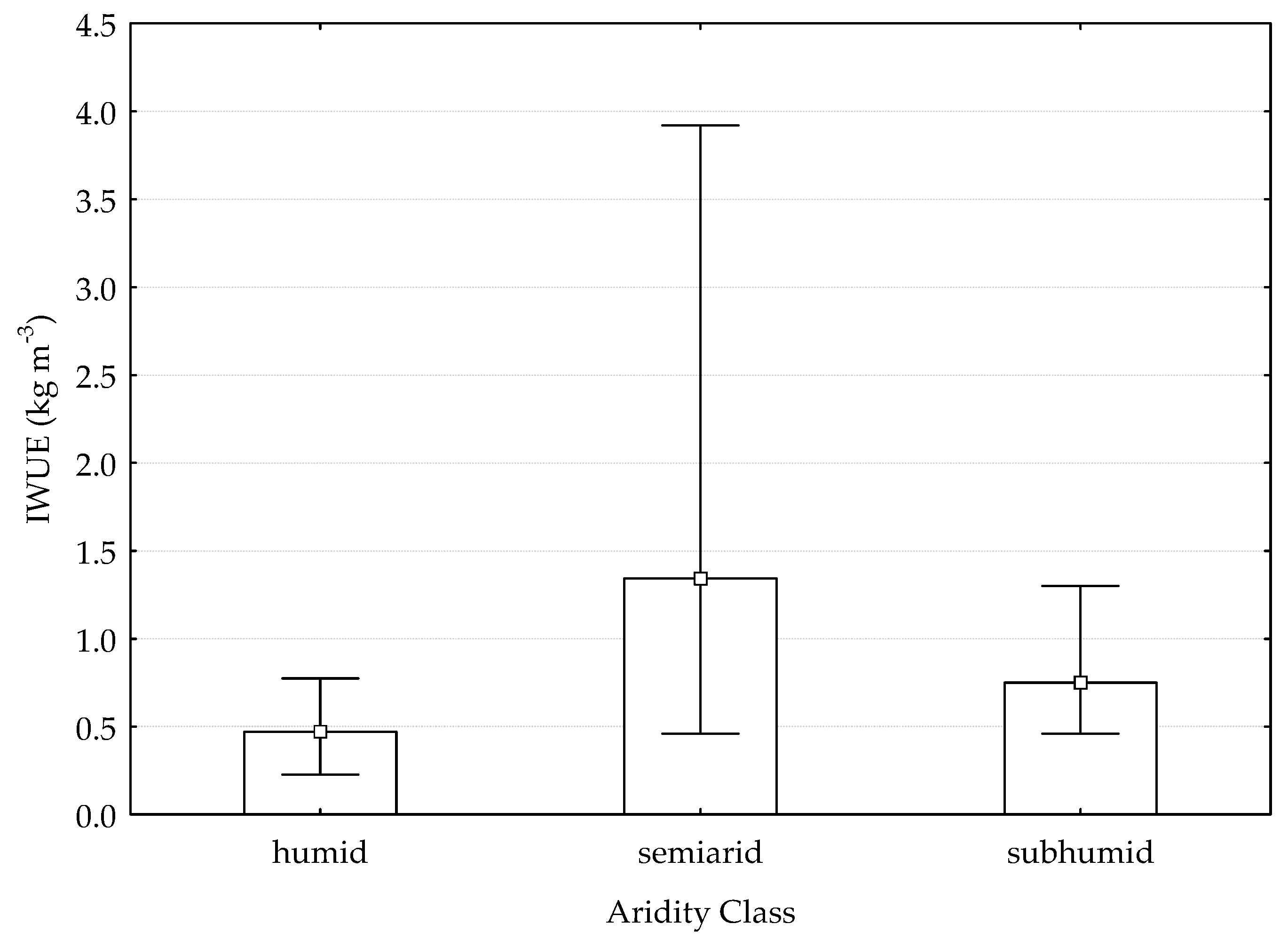
© 2019 by the authors. Licensee MDPI, Basel, Switzerland. This article is an open access article distributed under the terms and conditions of the Creative Commons Attribution (CC BY) license (http://creativecommons.org/licenses/by/4.0/).
Share and Cite
Francaviglia, R.; Di Bene, C. Deficit Drip Irrigation in Processing Tomato Production in the Mediterranean Basin. A Data Analysis for Italy. Agriculture 2019, 9, 79. https://doi.org/10.3390/agriculture9040079
Francaviglia R, Di Bene C. Deficit Drip Irrigation in Processing Tomato Production in the Mediterranean Basin. A Data Analysis for Italy. Agriculture. 2019; 9(4):79. https://doi.org/10.3390/agriculture9040079
Chicago/Turabian StyleFrancaviglia, Rosa, and Claudia Di Bene. 2019. "Deficit Drip Irrigation in Processing Tomato Production in the Mediterranean Basin. A Data Analysis for Italy" Agriculture 9, no. 4: 79. https://doi.org/10.3390/agriculture9040079
APA StyleFrancaviglia, R., & Di Bene, C. (2019). Deficit Drip Irrigation in Processing Tomato Production in the Mediterranean Basin. A Data Analysis for Italy. Agriculture, 9(4), 79. https://doi.org/10.3390/agriculture9040079





